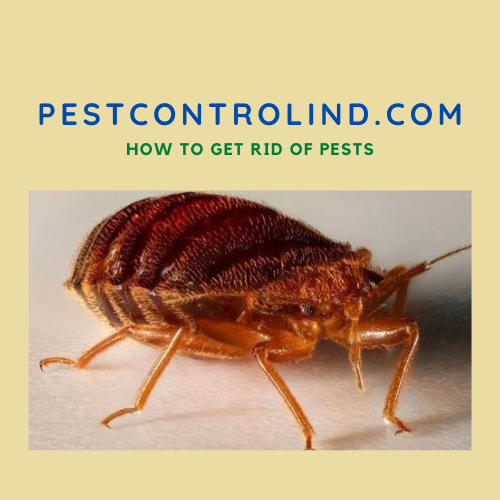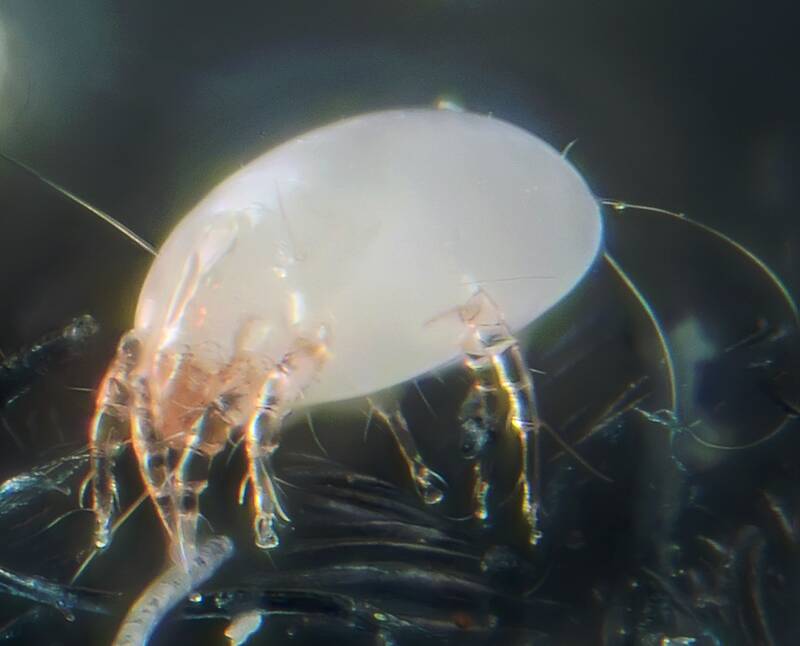How to know if you have dust mites in your bed when they are tiny insects that could not see with the naked eye? Let’s see together how to detect them, their danger, and how to get rid of them permanently.
I. Description of dust mites
Mites are arachnids, the family of spiders and scorpions. They measure on average between 0.1 and 0.6 millimeters, so it is often impossible to see them with the naked eye.
Females are usually much larger than males. However, among the 40,000 species, some are several centimeters long (especially ticks).
Mites do not like the cold, it puts them in a state of hibernation but does not kill them. They prefer warm places (over 20° C) and between 50 and 80% humidity.
This is why they often take shelter behind the furniture of your living room, in the curtains, on the carpet, and under the rugs but also and especially in your sheets.
The heat of your body, your nightly perspiration as well as the dead skin that settles there allow a rapid proliferation of these parasites in your bed.
If there can be up to 10,000 individuals on a single grain of dust, 2 million can be found in your bed.
II. What dust mites eat
Dust mites can also live on your face. They eat the excess sebum and your hair follicles, eyelashes, and eyebrows.
They also feed, as already mentioned above, on the dead skin of humans and animals, which is found mainly in the dust.
Moreover, dust mites themselves represent about 90% of the dust present in houses.
Their droppings can represent 200 times their weight in a lifetime. If this is very little for an individual, when it comes to millions of dust mites, it is another matter.
III. Life cycle of a mite
Mites have a relatively short lifespan, between 50 and 100 days. This does not prevent rapid reproduction.
They reproduce more in winter and fall when the air is very humid. Each female lays between 30 and 300 eggs in her lifetime.
The mite eggs hatch 3 days after being laid. They then pass through the larval stage, then protonymph and deutonymph before becoming adults.
The transformation is done in less than 10 days. Then, they continue to feed and reproduce until their death.
IV. How to detect dust mites
There are up to 2 million dust mites in each bed. The best way to detect their presence is to suffer from them, i.e. to be allergic.
So, if symptoms appear, dust mites are surely present. Unfortunately, they are not visible to the naked eye. However, there are certain signs that indicate their presence, such as the rapid accumulation of dust under your bed and in your room.
You are more likely to have dust mites in your home if your bedroom is damp and heated or poorly ventilated.
Also, poorly cleaned homes are the most likely to harbor them.
V. How to know if you have dust mites in your bed
Dust mite allergies are also known as dust allergies. These allergies are caused by a protein found in the shell debris of these insects and their droppings.
This is why dust mites are ineffective. They do kill the mites, but the allergens are still present.
Dust mite allergy develops when too many dust mites are present in a room. The allergens are breathed in through the nose and mouth and come into contact with the eyes.
This can cause irritation to the mucous membranes, especially the eyes (conjunctivitis). But allergies also cause the appearance of eczema, frequent sneezing, or sleep disorders.
For people predisposed to dust mite allergies, one of the most serious and frequent symptoms is an asthma attack.
This type of allergy is particularly common in the elderly, children, and teenagers. If symptoms appear, you should make an appointment with your doctor as soon as possible, in the case of a persistent asthma attack (more than one minute), you should go to the emergency room.
Note that 5% of the world’s people are asthmatic, more than half of which is due to dust mites. It is recommended that people suffering from persistent symptoms do a test to know if they are allergic.
To relieve the symptoms, a doctor can prescribe antihistamines or desensitization treatments.
VI. How to get rid of dust mites in Bed
As we have just seen how to know if we have dust mites, we now turn to how to eliminate them from our mattresses and our homes.
Here are some very useful tips to get rid of them permanently.
1. Humidity and heating in your home
As we have seen, dust mites love warm and humid places. That’s why they are factors to be regulated in your home.
Do not heat your home above 20°C. The recommended temperatures are 19°C for your living room and kitchen, 18°C for your bedroom, and 20°C for your bathroom.
To limit humidity in your home, limit the presence of green plants, aquariums, and humidifiers indoors.
It is also recommended that you use a clothes dryer rather than letting the water evaporate directly into the air in your home.
You can also look for potential water leaks under your sink, toilet, or shower and repair them.
Avoid standing water in your bathroom or kitchen.
2. Ventilation
In order to renew the air in your home, eliminate humidity and refresh your home, it is important to air all rooms.
Air your room after you wake up and before you go to bed for about fifteen minutes each time.
Open your bathroom windows wide after your shower for at least 10 minutes. For the living room air for at least 20 minutes a day, and the same for your kitchen.
3. Vacuum cleaner
These tiny insects are the main components of dust. A good way to get rid of both dust mites and their corpses is therefore to vacuum regularly.
It is recommended to vacuum your home weekly. Think mainly of the corners of the rooms, under your furniture, on the slats of your box spring, and on your mattress.
Always use a vacuum cleaner equipped with a filter.
4. Baking soda
Baking soda (or sodium bicarbonate) is a very effective miticide. Twenty grams of baking soda can kill all the mites in a square meter in a few hours.
Moreover, baking soda is not dangerous for humans or most pets. Baking soda will act on the chitin, an element that mainly makes up the insect’s carapace.
It will therefore eat away the chitin until it touches and kills the insect in a few minutes. Moreover, their great mobility will ensure that they are all contaminated by baking soda.
There are several ways to spread baking soda in contaminated areas. The first method is to sprinkle baking soda as evenly as possible on your bed, rugs, and carpets.
Count about 20 grams per square meter. The finer the baking soda powder, the more effective it is. Wait 4 to 8 hours before cleaning your sheets.
The second solution is to prepare a mixture of baking soda and water to spray on clothes, sheets, or curtains.
You can also pour it into your washing machine. While this solution is very effective, white spots may appear.
Don’t worry, the stains will wash away. The third solution is a very effective way to kill dust mites under your furniture. After vacuuming up all the dust you can, place the baking soda on the floor and vacuum it up. This way all the vacuumed dust mites will be eradicated by the baking soda.
5. Bedding hygiene
To avoid millions of dust mites in your bed, bedding hygiene is a priority.
Wash your sheets, blankets, and comforter covers every week at 60° C, even wool blankets.
Wash your blankets and pillows every 3 months. Change your pillows every 2 years and the rest of your bedding every 10 years.
Let your bed air out for an hour after you get up, then make your bed properly. This way, moisture, and heat will escape from your box spring.
6. Dust mite covers and sheets
There are some supplies to consider when you want to actively fight dust mites. Latex mattresses are preferable to wool mattresses.
Similarly, synthetic bedding is preferable to wool, cotton, or feather bedding. If you have a fabric bed base (called a box spring), consider changing it for a wooden slatted bed base.
Some covers can protect mattresses from dust mites. But these covers are often very expensive but very effective.
In any case, wash these covers every month. If you have a child with allergies, loft beds can limit the number of dust mites.
7. Pets
Pets deposit a lot of dead skin and hair. These items are prime food for dust mites.
Therefore, if possible, avoid letting your pets in your rooms, especially on your bed.
Pets should also be showered regularly.
8. Carpets and rugs
Dust mites like surfaces where they can live, breed in warmth, and where dead skin and hair fall.
Carpets and rugs are therefore among the favorite places for dust mites. To limit their proliferation on these surfaces, wash them regularly.
There are special powders for washing carpets and rugs that should be chosen for better efficiency.
The best is of course not to have carpets at home and to opt for short pile carpets. Between comfort and health, sometimes you have to find a balance (or not).
9. Cuddly toys, books, trinkets…
Dust mites live just about everywhere in the house. So put books away in closed bookcases, children’s toys in cupboards or chests, tidy up your desk, fold your laundry well, and also put it away in a closed space (chest of drawers, cupboard, closet…).
Be careful with dirty laundry, put it in a closed laundry bag if possible. Take care to wash your children’s stuffed animals regularly.
10. Essential oils
This tip allows both to force the departure of dust mites and to embalm your house with a pleasant smell.
They are very sensitive to the smell of lilac, lemon, tea tree, lavender, eucalyptus, or neem.
A few drops and water in a diffuser are enough. It is also recommended to scent your bedding to scare away arachnids from the bed.
Note of course that essential oils alone are not effective if they are not accompanied by the other tips listed above.
Useful Links:
Long-term efficacy of house dust mite reduction strategies
Heat Treatment for Termites: A Game Changer in Pest Control?

